Editorial: A warning and plan for a future Bend school levy
Published 5:00 am Saturday, September 14, 2024

- Bend-La Pine Schools board member Amy Tatom asks Scott Maben, the district's director of communications, about the school levy on Sept. 10.
The good thing about the loss of the May levy for the Bend-La Pine Schools for people who hoped it would pass is that it is possible to better understand why it failed.
The district took a deeper dive into the reasons for its failure. The findings were presented to the school board on Sept. 10.
The results are a warning about the future of any financial request and also give the district insight into what it might do to pass a levy.
The levy asked voters if they would support a levy of $1 per $1,000 of assessed value for five years. It failed, 25,133 no votes to 18,794 yes votes.
Surveys conducted for the district before the election showed that it might narrowly pass at 51%. The district also crafted the levy so it would provide money for things poll respondents said they wanted: protecting class sizes, more effort on career and technical education, recruiting and keeping staff, helping struggling students and offering more electives in things such as art, music and more.
The levy still lost handily, 57% to 43%.
If you were to look at a map of Bend, support was strongest in the city’s West side precincts and grew basically less strong away from that area and further out into the county and toward La Pine.
There did not seem to be a strong correlation by precinct between the number of students per registered voters and the support for the levy.
You don’t need to do a survey to guess some of the reasons why the levy failed.
When an election is about money, the results usually have something to do with money. We heard people say the district was asking for too much. We also heard some confusion — common with any change in property taxes — that the levy would charge people based on the assessed value of a home rather than the sale value.
A survey conducted for the district in June found much of the opposition was not so much a lack of confidence in the district as it was a concern about paying for the levy. That survey interviewed 400 likely voters. A total of 206 said they voted for the levy, 160 voted no and 34 reported not voting but knew about it. Nelson Research put the margin of error for its results at 5%.
It is likely that some people who said they voted for the levy in the June survey may have actually voted no.
It’s not unusual for people to want to be seen as “voting for schools” when they did not.
The people who said they voted no and even those who said they voted yes had the same top two reasons for “no” votes, though they were in different order. They were: the levy amount was too high and affordability of new taxes in the economy.
Perhaps the worst message in the June follow-up survey is what it suggested about the growing population of voters aged 60-plus. Support for the levy softened for that age cohort from 46% in January to about 41% in the June survey. There was also notable opposition from non-affiliated voters because of similar affordability issues.
All respondents were also asked what the district could do to improve on future levies. Better communication was the top response followed by reducing the cost of the levy.
District staff came to two conclusions: time and money. It might help communication about the levy if the district had more lead time before the vote, maybe a year. The district voted at the end of February to put the levy on the May ballot. More time could help eliminate confusion about the levy’s cost and give the district more time to get its message out about why the levy was necessary and what it would do. And perhaps asking for less would have earned more votes.
It’s not a recipe for guaranteed success. It’s a plan to do better.







